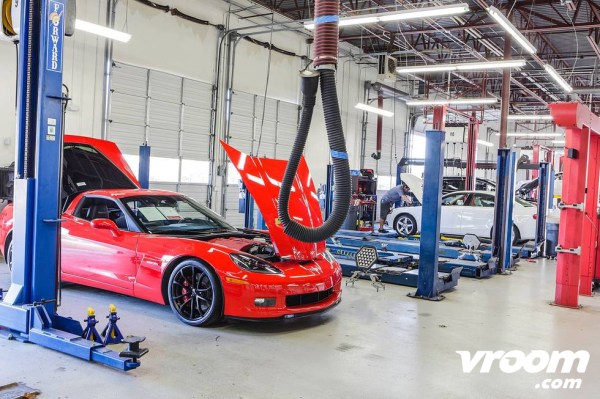Vroom, an on-demand car buying and selling startup that has raised over $300 million in venture funding, has hit a bump in the road. TechCrunch has learned and confirmed that the company has laid off a sizeable proportion of its staff — in line with a strategy of “sharpening our focus on profitability,” according to a company spokesperson.
As part of that move, a source tells us that the startup has closed two major locations in Dallas, Texas and Whitestown, Indiana, and cut around one-quarter of staff in New York City (where Vroom is headquartered) and Stafford, Texas.
A statement from a Vroom spokesperson confirmed the layoffs but did not specify locations or numbers:
“While Vroom’s business is healthy and financially stable, we are always looking to align our resources to fulfill our long-term vision and deliver on our mission,” the statement said. “In sharpening our focus on profitability, we recently made some adjustments to our strategy that has impacted our headcount. While decisions like this are never easy, we are putting the company in a better position to become the leader in online car buying and continue to invest in future areas of growth.”
Our tipster estimated that as much as 50 percent of the company’s staff has been let go since the beginning of the year, with the latest tranche of 25 percent of staff in New York City and Stafford, Texas, leaving in the last two weeks.
Asked about the numbers, the spokesperson for Vroom only said the number affected was “less than 50 percent” but did not specify a percentage, nor how many people currently work at the company. LinkedIn lists 283 employees at Vroom; the company’s site notes 845 employees.
While there are a few people complaining about cars and communication on Twitter, it appears that it’s mostly still business as usual at the company.
The moves underscore some of the challenge of scaling and running startups in the area of online used car sales amid the hundreds of millions of dollars that are being invested in the space.
Vroom has raised around $320 million from investors like General Catalyst, T. Rowe Price and Altimeter — most recently it closed a $76 million funding round last July that valued it at just under $655 million, according to PitchBook. In May last year, Softbank led a huge round in Germany’s Auto1 that valued the company at $2.8 billion. And while Carvana had a rocky start when it went public last year, its share price has bounced up and the company is now valued at $2.47 billion.
The layoffs come in the wake of tumultuous times for some of Vroom’s other competitors.
In the UK, both Carspring and Hellocar shut down last year. Shift, meanwhile, laid off staff and paused operations in at least one market, but also eventually raised more funding led by BMW.
Perhaps biggest of all was Beepi, which blew through $150 million in funding before two potential sales fell through and it was sold for parts.
Two of those parts, it turns out, were acquired by Vroom. For a while, beepi.com redirected to Vroom’s (it no longer seems to, although you can still find the redirect via the Wayback Machine). Vroom also acquired a small amount of software from Beepi, CEO Paul Hennessy told me last autumn.
Like Beepi and others, Vroom’s service caters both to individuals selling cars as well as those buying them. But Hennessy is clear to say that Vroom “is not a marketplace in any way,” because it buys in the cars, reconditions them and then resells.
“Marketplaces bring together buyers and sellers an then have little value add,” Hennessy said. “We curate and bring that content to consumers. In a vertical that lacks trust like used cars, we believe that building a platform, with the warranties and service, is what separates us.”
Sellers are given appraisals remotely. Vroom says that this appraisal uses live people, but also data science models based on market data. “We’ve achieved a level of perfection on inventory terms and buying what the market wants, rather than what buyers think might be sexy or a good opportunity,” said Hennessy.
If they accept the price, Vroom buys in the vehicle, and pays the individual by direct deposit when Vroom comes to collect the car. Vroom then adds the car on to its catalog for buyers, who can arrange for financing and then get the car delivered to a driveway when it’s purchased. That shipping service to consumers grew at a triple-digit rate last year.
Vroom, it seems, has not managed to sidestep some of the costlier aspects of selling vehicles, and that may point in part to why the company is reorganising.
One challenge is marketing to raise its profile. “Vroom has low awareness today outside of the Texas area,” Hennessy said last autumn.
Another issue is costs related to the nature of selling cars, particular those you are picking up and then delivering door-to-door across a wide geographic footprint.
“It’s a capital intensive business,” Hennessy admitted in September last year. He said that Vroom’s inventory floor plan at the time was in excess of $100 million, on top of the factories and their workers who reconditioned vehicles, and the other engineers and technicians on its team.
Currently there are 2,406 vehicles on sale on the site, and Vroom says that it has sold over 250,000 vehicles to date.
“What’s different about Vroom,” Hennessy said, “is that we look like a startup but are built on top of a business that’s been running for fifteen years, Texas Direct Auto,” which it acquired in 2015. “You can call it high tech or e-commerce, but with people who understand auto operations, as well as the perils of them.”
The question now is whether Vroom’s staff restructure will do enough it help it avoid those perils, too.
